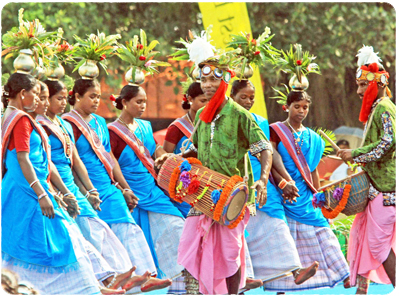Architecture in Jharkhand

Jharkhand, a state known for its rich cultural heritage and architectural diversity, offers a fascinating mix of traditional tribal architecture, historic temples, colonial-era structures, and modern urban developments. From the mud houses of indigenous tribes to the grand temples of Deoghar and the growing cityscapes of Ranchi and Jamshedpur, Jharkhand's architecture is a testament to its vibrant history and evolving infrastructure.
Jharkhand’s architecture is a perfect blend of tradition and modernity. While rural areas preserve the rich heritage of tribal and temple architecture, urban centers like Ranchi, Jamshedpur, and Dhanbad are evolving with contemporary designs and smart city developments. This unique fusion of historic charm and modern innovation makes Jharkhand a must-visit destination for architecture enthusiasts and history lovers.
Traditional Tribal Architecture in Jharkhand
Jharkhand is home to several tribal communities like the Santhal, Munda, Ho, and Oraon, who have preserved their unique architectural traditions for centuries. Their houses are built using locally available materials like bamboo, mud, and thatch, making them eco-friendly and sustainable. Key features of tribal architecture in Jharkhand include:
- Thatched or Tiled Roof Huts- Made from mud, bamboo, and natural fibers, these homes provide insulation against extreme weather conditions
- Penkh (Open Courtyards) -Small open spaces within homes that allow natural ventilation and communal activities.
- Tribal Wall Art & Murals -Homes are decorated with vibrant paintings depicting nature, folklore, and tribal deities, adding to the aesthetic appeal.
Famous Temples and Religious Architecture in Jharkhand
Jharkhand boasts some of India’s most revered temples, known for their distinct architectural styles and historical significance. Key religious sites include:
- Baidyanath Temple, Deoghar -One of the twelve Jyotirlingas, this ancient temple follows the Nagara style of architecture, featuring a pyramidal tower and intricate carvings.
- Sun Temple, Ranchi - Built in the shape of a chariot with twelve wheels, this temple combines traditional and modern architectural elements.
- Maluti Temples, Dumka -A collection of terracotta temples showcasing detailed carvings and mythological depictions
Colonial and Modern Architecture in Jharkhand
Jharkhand also carries influences from the British colonial era, especially in cities like Ranchi and Jamshedpur, where churches, railway stations, and administrative buildings feature European architectural designs. In recent years, the state has embraced modern urban architecture, with smart cities, industrial hubs, and sustainable buildings transforming the skyline. Notable examples include:
- Jubilee Park, Jamshedpur -Inspired by European garden architecture, this park seamlessly integrates landscape design with urban planning.
- Ranchi Smart City - A developing eco-friendly urban center that incorporates smart infrastructure, green buildings, and modern amenities.
Sustainable and Eco-Friendly Architecture in Jharkhand
With its abundant natural resources, Jharkhand is becoming a hub for sustainable architecture. Many modern structures, including eco-resorts, lodges, and residential projects, emphasize:
- Locally sourced materials like stone and wood for environmentally friendly construction.
- Solar energy and green roofs to promote sustainable living
- Rainwater harvesting systems to support water conservation efforts.